Silibinin Downregulates Types I and III Collagen Expression via Suppression of the mTOR Signaling Pathway
Abstract
:1. Introduction
2. Results
2.1. Clinical Information of Investigated Tissue Samples
2.2. mTOR Phosphorylation Is Elevated in Active Keloid Scar Compared to the Normal Tissue Specimen
2.3. Effect of Silibinin on Cell Viability in HDFs and KFs
2.4. Silibinin Significantly Reduced Collagen I and III mRNA Transcripts in TGF-β1-Treated HDFs and KFs
2.5. Silibinin Effectively Suppressed the mTOR Signaling Pathway in HDFs and KFs
3. Discussion
4. Materials and Methods
4.1. Collection of Keloid and Normal Tissue Samples
4.2. Cell Lines, Cell Culture, and Isolation of Fibroblasts from Keloid Tissues
4.3. Natural Phytochemical
4.4. Cell Viability Assay
4.5. Histological Examination and Immunohistochemistry (IHC) Analyses
4.6. Quantitative Reverse Transcription–Polymerase Chain Reaction (qRT-PCR)
4.7. Immunoblotting Assay
4.8. Statistical Analysis
Author Contributions
Funding
Institutional Review Board Statement
Informed Consent Statement
Data Availability Statement
Conflicts of Interest
References
- Gauglitz, G.G.; Korting, H.C.; Pavicic, T.; Ruzicka, T.; Jeschke, M.G. Hypertrophic scarring and keloids: Pathomechanisms and current and emerging treatment strategies. Mol. Med. 2011, 17, 113–125. [Google Scholar] [CrossRef] [PubMed]
- Brown, B.C.; McKenna, S.P.; Siddhi, K.; McGrouther, D.A.; Bayat, A. The hidden cost of skin scars: Quality of life after skin scarring. J. Plast. Reconstr. Aesthet Surg. 2008, 61, 1049–1058. [Google Scholar] [CrossRef]
- Atiyeh, B.S. Nonsurgical management of hypertrophic scars: Evidence-based therapies, standard practices, and emerging methods. Aesthetic Plast. Surg. 2007, 31, 468–492; discussion 493–494. [Google Scholar] [CrossRef] [PubMed]
- Shih, B.; Garside, E.; McGrouther, D.A.; Bayat, A. Molecular dissection of abnormal wound healing processes resulting in keloid disease. Wound Repair Regen. 2010, 18, 139–153. [Google Scholar] [CrossRef] [PubMed]
- Saxton, R.A.; Sabatini, D.M. Mtor signaling in growth, metabolism, and disease. Cell 2017, 168, 960–976. [Google Scholar] [CrossRef] [PubMed]
- Ong, C.T.; Khoo, Y.T.; Mukhopadhyay, A.; Do, D.V.; Lim, I.J.; Aalami, O.; Phan, T.T. Mtor as a potential therapeutic target for treatment of keloids and excessive scars. Exp. Dermatol. 2007, 16, 394–404. [Google Scholar] [CrossRef] [PubMed]
- Zhai, X.X.; Tang, Z.M.; Ding, J.C.; Lu, X.L. Expression of tgf-beta1/mtor signaling pathway in pathological scar fibroblasts. Mol. Med. Rep. 2017, 15, 3467–3472. [Google Scholar] [CrossRef]
- Shegogue, D.; Trojanowska, M. Mammalian target of rapamycin positively regulates collagen type i production via a phosphatidylinositol 3-kinase-independent pathway. J. Biol. Chem. 2004, 279, 23166–23175. [Google Scholar] [CrossRef]
- Bijak, M. Silybin, a major bioactive component of milk thistle (silybum marianum l. Gaernt.)-chemistry, bioavailability, and metabolism. Molecules 2017, 22, 1942. [Google Scholar] [CrossRef]
- Wellington, K.; Jarvis, B. Silymarin: A review of its clinical properties in the management of hepatic disorders. BioDrugs 2001, 15, 465–489. [Google Scholar] [CrossRef]
- Di Sario, A.; Bendia, E.; Taffetani, S.; Omenetti, A.; Candelaresi, C.; Marzioni, M.; De Minicis, S.; Benedetti, A. Hepatoprotective and antifibrotic effect of a new silybin-phosphatidylcholine-vitamin e complex in rats. Dig. Liver Dis. 2005, 37, 869–876. [Google Scholar] [CrossRef] [PubMed]
- Garcia-Maceira, P.; Mateo, J. Silibinin inhibits hypoxia-inducible factor-1alpha and mtor/p70s6k/4e-bp1 signalling pathway in human cervical and hepatoma cancer cells: Implications for anticancer therapy. Oncogene 2009, 28, 313–324. [Google Scholar] [CrossRef] [PubMed]
- Cho, J.W.; Il, K.J.; Lee, K.S. Downregulation of type i collagen expression in silibinin-treated human skin fibroblasts by blocking the activation of smad2/3-dependent signaling pathways: Potential therapeutic use in the chemoprevention of keloids. Int. J. Mol. Med. 2013, 31, 1148–1152. [Google Scholar] [CrossRef] [PubMed]
- Syed, F.; Sherris, D.; Paus, R.; Varmeh, S.; Singh, S.; Pandolfi, P.P.; Bayat, A. Keloid disease can be inhibited by antagonizing excessive mtor signaling with a novel dual torc1/2 inhibitor. Am. J. Pathol. 2012, 181, 1642–1658. [Google Scholar] [CrossRef] [PubMed]
- Zarogoulidis, P.; Lampaki, S.; Turner, J.F.; Huang, H.; Kakolyris, S.; Syrigos, K.; Zarogoulidis, K. Mtor pathway: A current, up-to-date mini-review (review). Oncol. Lett. 2014, 8, 2367–2370. [Google Scholar] [CrossRef]
- Dennis, P.B.; Jaeschke, A.; Saitoh, M.; Fowler, B.; Kozma, S.C.; Thomas, G. Mammalian tor: A homeostatic atp sensor. Science 2001, 294, 1102–1105. [Google Scholar] [CrossRef]
- Loewith, R.; Hall, M.N. Target of rapamycin (tor) in nutrient signaling and growth control. Genetics 2011, 189, 1177–1201. [Google Scholar] [CrossRef]
- Andreoli, A.; Ruf, M.T.; Itin, P.; Pluschke, G.; Schmid, P. Phosphorylation of the ribosomal protein s6, a marker of mtor (mammalian target of rapamycin) pathway activation, is strongly increased in hypertrophic scars and keloids. Br. J. Dermatol. 2015, 172, 1415–1417. [Google Scholar] [CrossRef]
- Rong, L.; Livingstone, M.; Sukarieh, R.; Petroulakis, E.; Gingras, A.C.; Crosby, K.; Smith, B.; Polakiewicz, R.D.; Pelletier, J.; Ferraiuolo, M.A.; et al. Control of eif4e cellular localization by eif4e-binding proteins, 4e-bps. RNA 2008, 14, 1318–1327. [Google Scholar] [CrossRef]
- Gingras, A.C.; Kennedy, S.G.; O’Leary, M.A.; Sonenberg, N.; Hay, N. 4e-bp1, a repressor of mrna translation, is phosphorylated and inactivated by the akt(pkb) signaling pathway. Genes Dev. 1998, 12, 502–513. [Google Scholar] [CrossRef]
- Gingras, A.C.; Raught, B.; Gygi, S.P.; Niedzwiecka, A.; Miron, M.; Burley, S.K.; Polakiewicz, R.D.; Wyslouch-Cieszynska, A.; Aebersold, R.; Sonenberg, N. Hierarchical phosphorylation of the translation inhibitor 4e-bp1. Genes Dev. 2001, 15, 2852–2864. [Google Scholar] [CrossRef] [PubMed]
- Oshiro, N.; Yoshino, K.; Hidayat, S.; Tokunaga, C.; Hara, K.; Eguchi, S.; Avruch, J.; Yonezawa, K. Dissociation of raptor from mtor is a mechanism of rapamycin-induced inhibition of mtor function. Genes Cells 2004, 9, 359–366. [Google Scholar] [CrossRef]
- Wong, V.W.; You, F.; Januszyk, M.; Gurtner, G.C.; Kuang, A.A. Transcriptional profiling of rapamycin-treated fibroblasts from hypertrophic and keloid scars. Ann. Plast. Surg. 2014, 72, 711–719. [Google Scholar] [CrossRef] [PubMed]
- Vostalova, J.; Tinkova, E.; Biedermann, D.; Kosina, P.; Ulrichova, J.; Rajnochova Svobodova, A. Skin protective activity of silymarin and its flavonolignans. Molecules 2019, 24, 1002. [Google Scholar] [CrossRef] [PubMed]
- Rozen-Zvi, B.; Hayashida, T.; Hubchak, S.C.; Hanna, C.; Platanias, L.C.; Schnaper, H.W. Tgf-beta/smad3 activates mammalian target of rapamycin complex-1 to promote collagen production by increasing hif-1alpha expression. Am. J. Physiol. Renal. Physiol. 2013, 305, F485–F494. [Google Scholar] [CrossRef] [PubMed]
- Woodcock, H.V.; Eley, J.D.; Guillotin, D.; Plate, M.; Nanthakumar, C.B.; Martufi, M.; Peace, S.; Joberty, G.; Poeckel, D.; Good, R.B.; et al. The mtorc1/4e-bp1 axis represents a critical signaling node during fibrogenesis. Nat. Commun. 2019, 10, 6. [Google Scholar] [CrossRef]
- Soleimani, V.; Delghandi, P.S.; Moallem, S.A.; Karimi, G. Safety and toxicity of silymarin, the major constituent of milk thistle extract: An updated review. Phytother. Res. 2019, 33, 1627–1638. [Google Scholar] [CrossRef]
- Bijak, M.; Synowiec, E.; Sitarek, P.; Sliwinski, T.; Saluk-Bijak, J. Evaluation of the cytotoxicity and genotoxicity of flavonolignans in different cellular models. Nutrients 2017, 9, 1356. [Google Scholar] [CrossRef]
- Rajnochova Svobodova, A.; Gabrielova, E.; Ulrichova, J.; Zalesak, B.; Biedermann, D.; Vostalova, J. A pilot study of the uva-photoprotective potential of dehydrosilybin, isosilybin, silychristin, and silydianin on human dermal fibroblasts. Arch. Dermatol. Res. 2019, 311, 477–490. [Google Scholar] [CrossRef]
- Mirzaaghaei, S.; Foroughmand, A.M.; Saki, G.; Shafiei, M. Combination of epigallocatechin-3-gallate and silibinin: A novel approach for targeting both tumor and endothelial cells. ACS Omega 2019, 4, 8421–8430. [Google Scholar] [CrossRef]
- Livak, K.J.; Schmittgen, T.D. Analysis of relative gene expression data using real-time quantitative pcr and the 2(-delta delta c(t)) method. Methods 2001, 25, 402–408. [Google Scholar] [CrossRef] [PubMed]
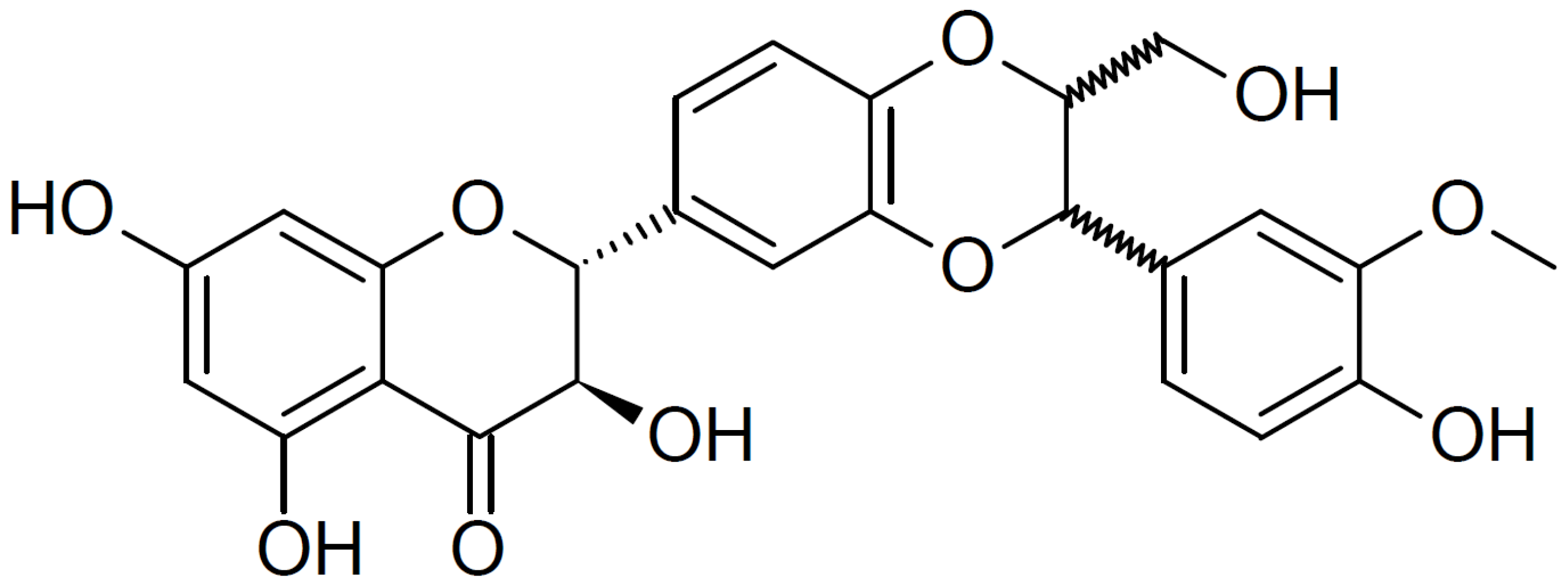

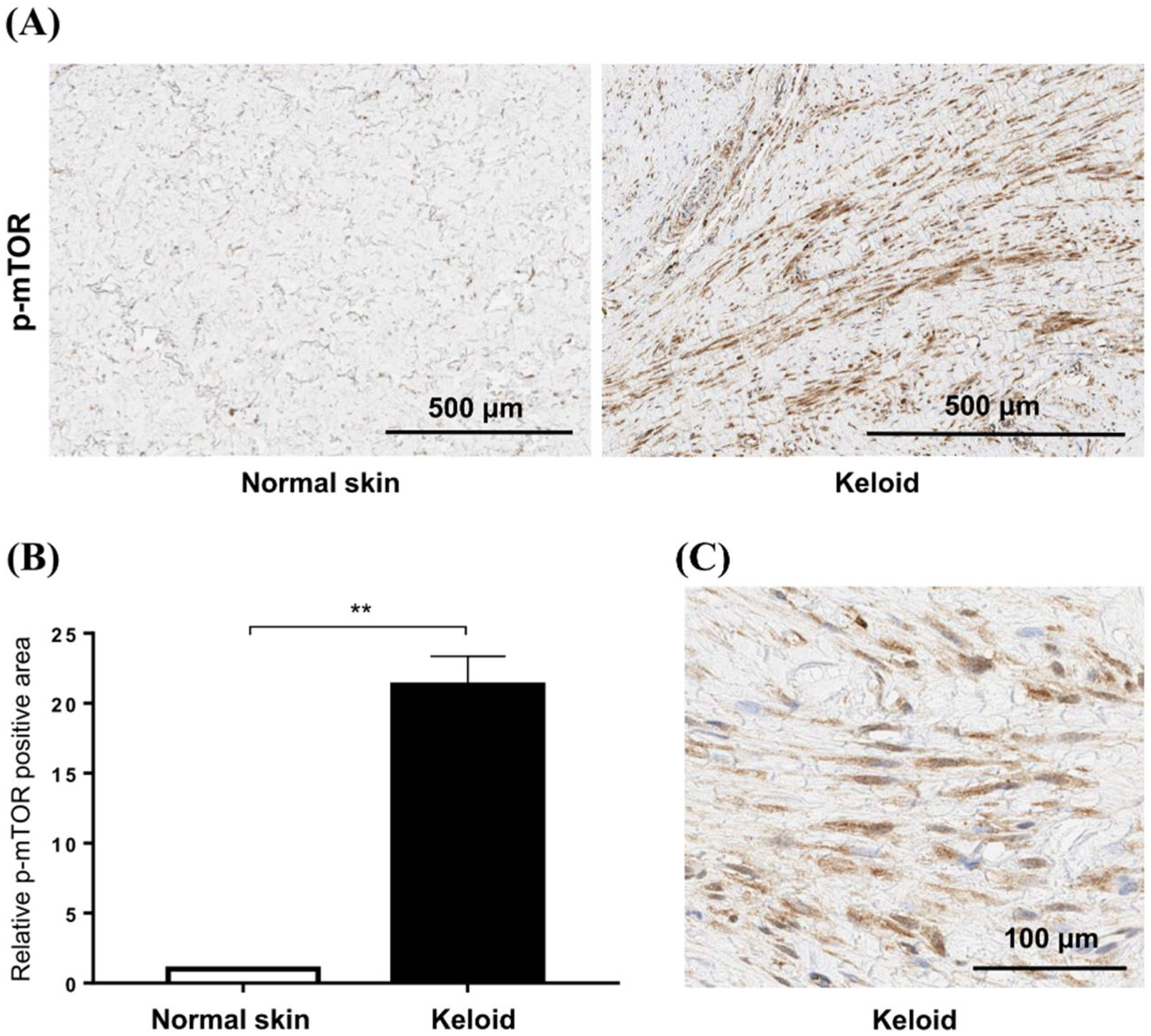
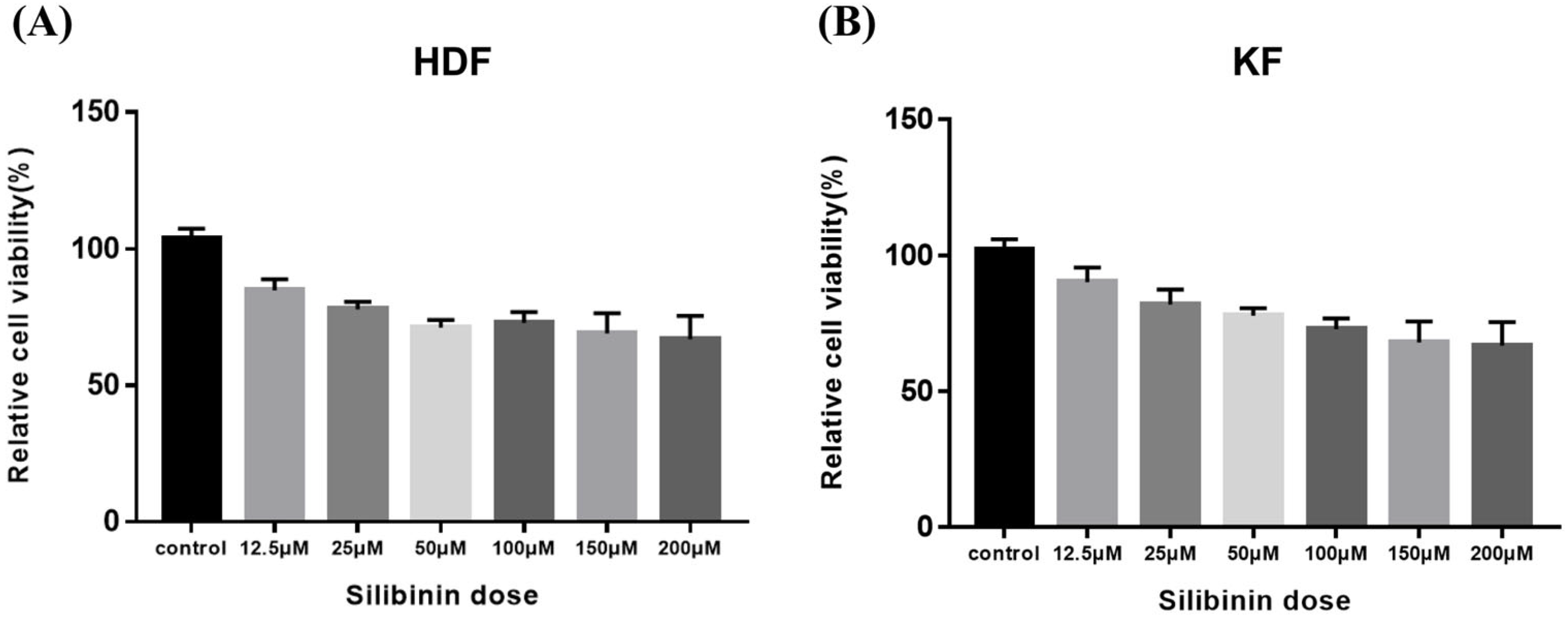

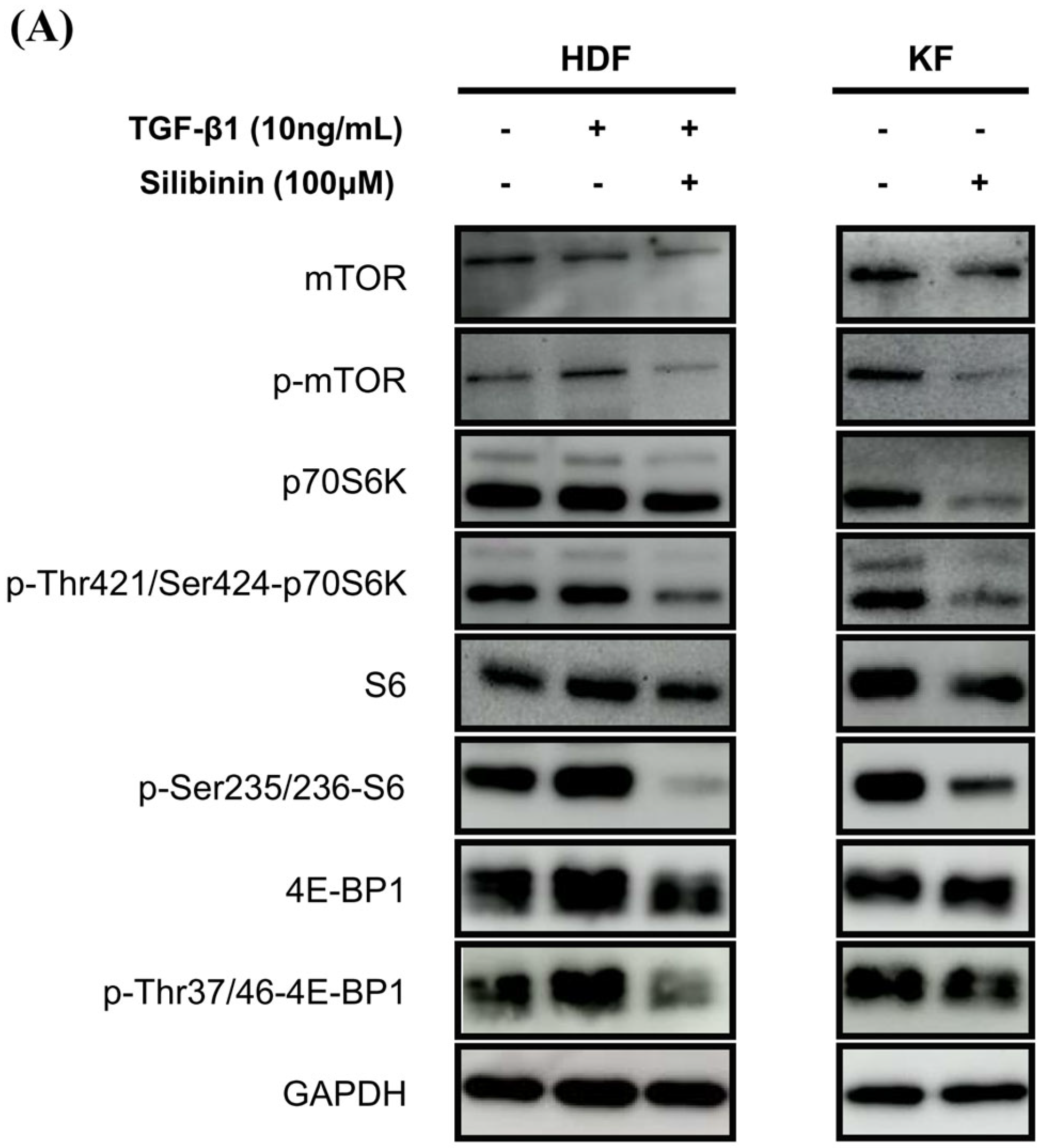

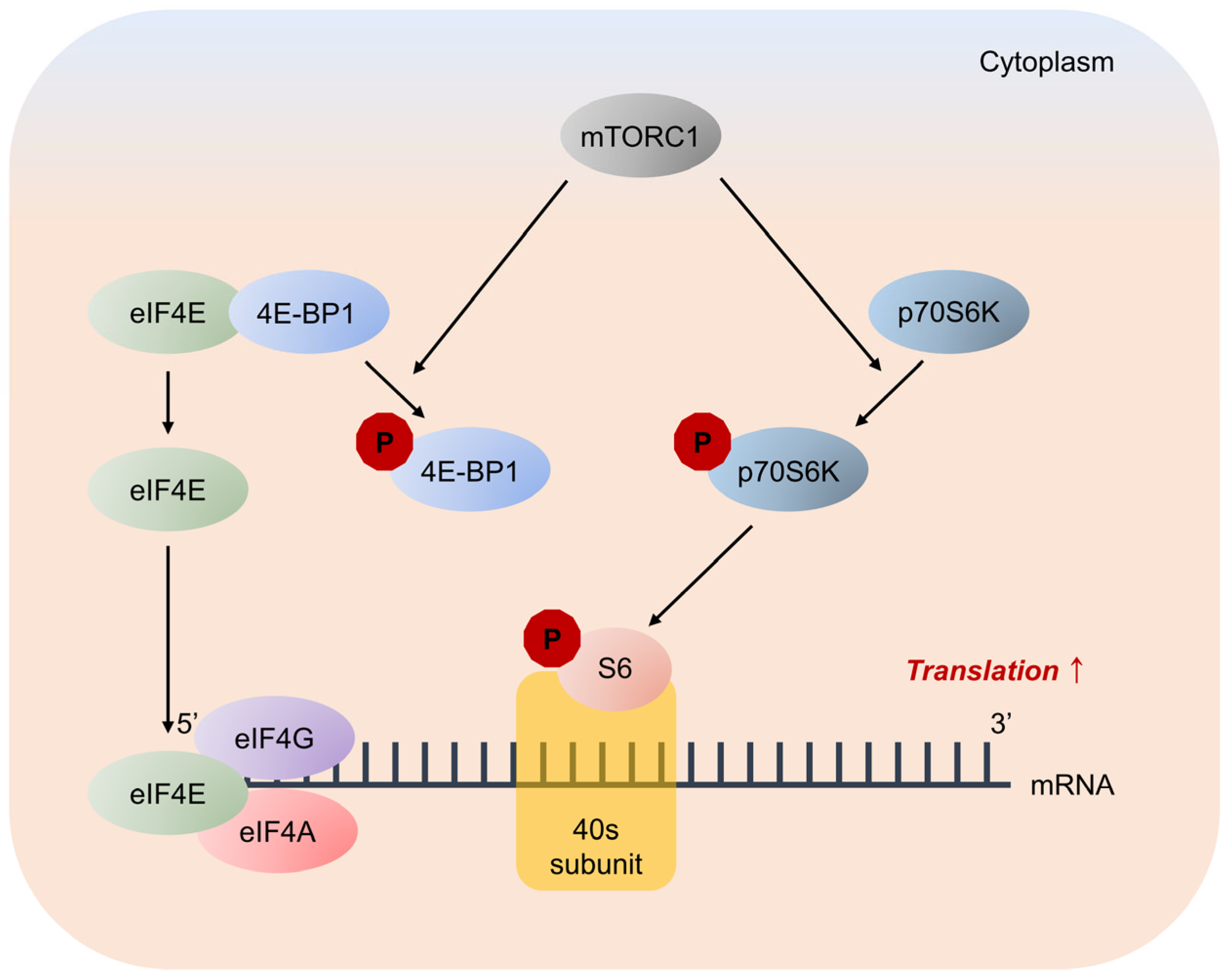

| Sex | Age (y) | Site | Duration of Scar (y) | Recurrence after Surgical Excision | Experiments Involving Tissue Sample | |
|---|---|---|---|---|---|---|
| Participants with keloid scars | ||||||
| 1 | F | 25 | Right ear | 1 | Yes | Cell isolation, IHC |
| 2 | F | 29 | Right ear | 2 | No | Cell isolation, IHC |
| 3 | M | 11 | Abdomen | 2.5 | No | IHC |
| 4 | F | 76 | Anterior chest | 1 | Yes | IHC |
| 5 | F | 51 | Abdomen | 2 | Yes | IHC |
| Donors of normal skin | ||||||
| 1 | F | 40 | Abdomen | - | IHC | |
| 2 | F | 38 | Abdomen | - | IHC | |
| 3 | F | 55 | Abdomen | - | IHC | |
| Target Gene | Primer Sequences (5′ → 3′) |
|---|---|
| COL1A1 | Forward: 5′-TGTTCAGCTTTGTGGACCTCCG-3′ Reverse: 5′-CCGTTCTGTACGCAGGTGATTG-3′ |
| COL3A1 | Forward: 5′-GAAGATGTCCTTGATGTGC-3′ Reverse: 5′-AGCCTTGCGTGTTCGATAT-3′ |
| GAPDH | Forward: 5′-CATGAGAAGTATGACAACAGCCT-3′ Reverse: 5′-AGTCCTTCCACGATACCAAAGT-3′ |
| Antibody | Host | Clonality | Isotype | Dilution | Product Code | Source |
|---|---|---|---|---|---|---|
| Primary antibodies | ||||||
| Collagen I | Rabbit | polyclonal | IgG | 1:1000 | NB600-408 | Novus Biologicals |
| Collagen III | Rabbit | polyclonal | IgG | 1:1000 | Ab7778 | Abcam |
| mTOR | Rabbit | polyclonal | IgG | 1:500 | PA5-34663 | Invitrogen |
| p-mTOR (Ser2448) | Rabbit | polyclonal | IgG | 1:1000 | 44-1125G | Invitrogen |
| 4E-BP1 | Rabbit | monoclonal | IgG | 1:1000 | 9644 | Cell Signaling Technology |
| p-4E-BP1 (Thr37/46) | Rabbit | monoclonal | IgG | 1:1000 | 2855 | Cell Signaling Technology |
| p70S6K | Rabbit | monoclonal | IgG | 1:1000 | 9202 | Cell Signaling Technology |
| p-p70S6K (Thr421/Ser424) | Rabbit | monoclonal | IgG | 1:1000 | 9204 | Cell Signaling Technology |
| S6 | Mouse | monoclonal | IgG1 | 1:1000 | 2317 | Cell Signaling Technology |
| p-S6 (Ser235/236) | Rabbit | polyclonal | IgG | 1:1000 | 2211 | Cell Signaling Technology |
| p-S6 (Ser240/244) | Rabbit | monoclonal | IgG | 1:1000 | 5364 | Cell Signaling Technology |
| GAPDH | Rabbit | monoclonal | NA | 1:1000 | 2118 | Cell Signaling Technology |
| Secondary antibodies | ||||||
| anti-rabbit IgG | Goat | NA | NA | 1:2000 | 7074 | Cell Signaling Technology |
| anti-mouse IgG | Goat | polyclonal | IgG | 1:2000 | SC-2005 | Santa Cruz Biotechnology |
Disclaimer/Publisher’s Note: The statements, opinions and data contained in all publications are solely those of the individual author(s) and contributor(s) and not of MDPI and/or the editor(s). MDPI and/or the editor(s) disclaim responsibility for any injury to people or property resulting from any ideas, methods, instructions or products referred to in the content. |
© 2023 by the authors. Licensee MDPI, Basel, Switzerland. This article is an open access article distributed under the terms and conditions of the Creative Commons Attribution (CC BY) license (https://creativecommons.org/licenses/by/4.0/).
Share and Cite
Choi, S.; Ham, S.; Lee, Y.I.; Kim, J.; Lee, W.J.; Lee, J.H. Silibinin Downregulates Types I and III Collagen Expression via Suppression of the mTOR Signaling Pathway. Int. J. Mol. Sci. 2023, 24, 14386. https://doi.org/10.3390/ijms241814386
Choi S, Ham S, Lee YI, Kim J, Lee WJ, Lee JH. Silibinin Downregulates Types I and III Collagen Expression via Suppression of the mTOR Signaling Pathway. International Journal of Molecular Sciences. 2023; 24(18):14386. https://doi.org/10.3390/ijms241814386
Chicago/Turabian StyleChoi, Sooyeon, Seoyoon Ham, Young In Lee, Jihee Kim, Won Jai Lee, and Ju Hee Lee. 2023. "Silibinin Downregulates Types I and III Collagen Expression via Suppression of the mTOR Signaling Pathway" International Journal of Molecular Sciences 24, no. 18: 14386. https://doi.org/10.3390/ijms241814386
APA StyleChoi, S., Ham, S., Lee, Y. I., Kim, J., Lee, W. J., & Lee, J. H. (2023). Silibinin Downregulates Types I and III Collagen Expression via Suppression of the mTOR Signaling Pathway. International Journal of Molecular Sciences, 24(18), 14386. https://doi.org/10.3390/ijms241814386






